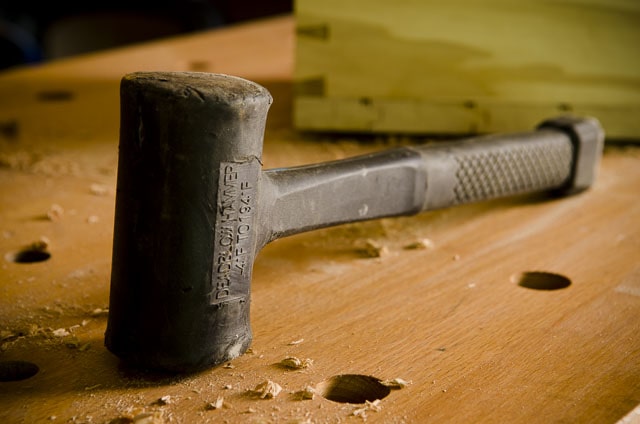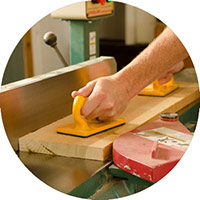
Disclosure: WoodAndShop.com is supported by its audience. When you purchase through certain links on our site, we may earn a small affiliate commission, at no cost to you. Learn more.
Introduction to Buying a Wood Mallet & Wooden Hammers for Woodworking
By Joshua Farnsworth
Looking for a wood mallet or wooden hammers may not be quite as exciting as researching what handplane to buy, but they are necessary, and there are some tips that you should know before you buy any wood mallet or wood hammer. Below you’ll see which whacking devices you’ll need and when. Just don’t use the wrong whacking tool to whack your tools, or you may need to buy new woodworking hand tools!
A. Urgent Woodworking Mallets & Hammers (Make or Buy These First)
Below are my recommendation for types & brands of woodworking mallets and hammers that you will likely need right at the start of your traditional woodworking journey. If you’re on a really tight budget, don’t fret. You can use your judgement to narrow down this list and make due without everything at first. Just make sure that you buy fewer tools at first, rather than lower quality tools. I guarantee that you’ll have to buy a better replacement down the road. But you can often find the highest quality antique tools for less money than poor quality new tools.
Make or Buy a Joiner’s Wood Mallet Mallet (for striking chisels)

There are several wood mallet styles for striking your chisels. A metal mallet or hammer should not be used to strike a chisel, unless you want to break the wooden handles of your wood chisels. A wood mallet should be used to strike your chisels. Most traditional woodworkers correctly use a larger English-style “Joiner’s Mallet” for hitting their chisels, like the below maple joiner’s mallets that I made for my woodworking school.

A Joiner’s wood mallet should be made out of a hard wood like oak, maple, etc. Roy Underhill showed how to make a joiner’s wood mallet in his classic TV show, “The Woodwright’s Shop”. You can watch the episode below (click here if the video doesn’t load):
But if you don’t feel comfortable making a joiner’s wood mallet yet, and you just want to get started woodworking, then here is a good wood mallet that you can purchase, which students use in my school:

This wood mallet is very suitable for cutting dovetails and chopping mortises. It’s a good size for most people – not too large and not too small. You can purchase this Crown Beechwood Mallet on Amazon for under $30.
Buy or make a Carver’s Wood Mallet

Many new traditional woodworkers mistakenly purchase these smaller, more delicate mallets for use in chopping with their chisels. This type of wood mallet can certainly be used for more delicate chisel work, but carver’s mallets are intended for use with carving chisels. Carving tools are covered in more detail in our carving tools buyer’s guide.

Buy a Wooden Handled Claw Hammer

It’s really nice to have a claw hammer for when you need to drive traditional cut nails into chest bottoms, etc. Also, I personally don’t like destroying my wooden joiner’s mallets when I hit my hold fasts, so I use a metal hammer for that task as well. I like the feeling and traditional look of a wooden hammer handle. Plus, there is less shock to my hands than with fiberglass or metal handles.
You can find vintage wood handled hammers at this eBay link.

Just make sure that the handle isn’t loose or rotted, and if they are, just decide if you want to spend the time to repair them. A good metal claw hammer should run you about $10.
B. Semi-Urgent Mallets & Hammers (Buy these next)
Below are my recommendation for types & brands of tools that you will need fairly soon after you get started in traditional woodworking. You may discover that you want to make something early on that requires some of the below tools:
Buy a White Rubber Mallet

If you use a dark headed rubber mallet to assemble your furniture you’ll soon realize that it leaves black marks. So a white mallet is pretty nice to have, but also inexpensive. I bought this white rubber mallet on Amazon for under $9 and it has held up just fine. Of course, you can skip buying a rubber mallet and just use a wooden joiner’s mallet to assemble your furniture, as long as you place a piece of scrap wood on your furniture to prevent marring. But a rubber mallet is more convenient than trying to hold the wooden mallet and scrap board.
Buy a Small Hammer for Adjusting Planes

Smaller hammers used for woodworking are called cross pein hammers (or “peen” hammer), warrington hammers, and joiner’s hammers (all very similar, but different weights). They are useful for many tasks, including hammering small nails, brads, and tacks. A narrow thin pein allows you to strike a small nail without smashing your fingers.
These small hammers are also very useful for adjusting hand planes. The lateral adjusting lever on metal hand planes is a bit brutish. Making micro-adjustments with a small hammer (like some sort of peen hammer) gives you more control. A little to the left…a little to the right.

A small pein hammer like this also enables you to adjust blades in wooden hand planes and molding planes. The small thin pein (or peen) allows you to get inside the plane’s escapement to make lateral adjustments like in this photo:

I recently found a great little mallet that has become useful in my workshop and woodworking school. I often use it for adjusting my handplanes: the Grace USA 16 ounce Brass Hammer with Delrin Tip. I like this mallet because I can use the brass end for tapping the iron and the derlin end for tapping the wooden wedge. The only downside is that it doesn’t have a cross pein for getting inside the escapement.

Here are some other small hammers that would work for adjusting hand planes:
- View hickory-handle Cross Peen hammer on Amazon ($14)…this is my favorite small hammer, which is pictured above.
- View vintage cross peen hammers on ebay ($5+)
- View Lie-Nielsen’s very nice brass cross peen hammer ($85)
- View Gramercy Tools Kings County Cabinetmaker’s Hammers ($150-$190)
Buy a Dead Blow Mallet

Rubber mallets rebound, which can be inconvenient when you’re trying to get a difficult workpiece to fit together. A dead blow mallet has metal BBs or sand in the head, which drives more energy into the swing. So I recommend buying an inexpensive dead blow mallet (like this one) for those situations. Just make sure you put a piece of wood between your furniture and this black mallet to prevent black or orange marks. Dead blow mallets run around $15.
Make a Froe Mallet and Large Log Riving Mallet

If you want to use a froe to split green wood, then you should make a froe mallet. If you want to rive (split) your own lumber from green logs, and you want to use wooden splitting gluts / wedges (I use metal and wood together) then you should make a larger version of the froe mallet, which I simply call a large wooden log riving mallet. These mallets are made the same way, but just on a different scale. For more information Check out our Green Woodworking Tool Buyer’s Guide here.

If you have access to a small section of a harder log or large branch (I use dogwood or maple or something similar) you can make it with a chainsaw (or even a handsaw) and hatchet. I found this video that should show you how easy it is (similar to how I made mine):
If possible, try to leave the bark on the froe mallet’s head until it falls off during use, and also use Anchorseal 2 on any end grain areas that are prone to checking/splitting.

Let the wooden mallets dry slowly outdoors (or in a trash can with shavings) to try to prevent checking. I also carved a handle to keep my hands from slipping when swinging this big mallet:

Continue to Hand Drills, Braces, & Bits Buyer’s Guide (#8)…
TOOL GUIDE SHORTCUTS:


HAND TOOL BUYER’S GUIDES
- Intro to Buying Woodworking Hand Tools
- Workbench & Tool Storage
- Layout, Marking, & Measuring Tools
- Handplanes
- Handsaws
- Chisels
- Sharpening & Honing Supplies
- Mallets & Hammers
- Hand Drills, Braces, & Bits
- Tools for Curved Work
- Tools for Green Woodworking
- Woodworking Clamps, Gluing & Fasteners
- Tools for Wood Carving
- Products for Wood Finishing, Sanding & Scraping
- Wood Turning Tools & Lathes



It seems that I don’t think ahead enough because I go looking for a tool I need exactly when I’m putting the project together. And I get frustrated when I can’t find what I need at the stores around where I live.
alfie hobason is a hand saw